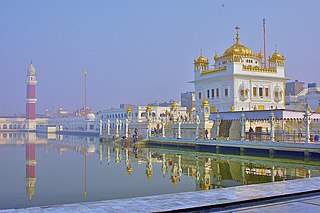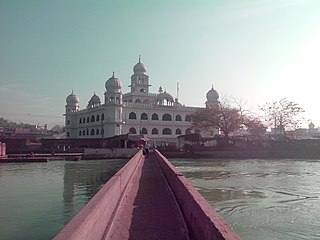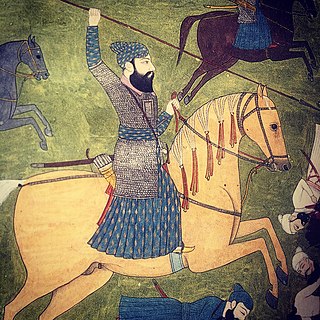
Tarn Taran Sahib is a city in the Majha region of the state of Punjab, in northern India. It is the district headquarters and hosts the municipal council of Tarn Taran district. Gurdwara Sri Tarn Taran Sahib, a prominent Sikh shrine, is located in the central part of the city.

Bhagat Dhanna, also known Dhanna Jat, Dhanna Jatt, Dhanna Bairagi or Sant Dhanna, was a mystic poet and a Vaishnav devotee whose three hymns are present in Guru Granth Sahib.

Chamkaur Sahib is a Sub Divisional town in the district of Rupnagar in the Indian State of Punjab.

Baba Deep Singh is revered among Sikhs as one of the most hallowed martyrs in Sikhism. He is remembered for his sacrifice and devotion to the teachings of the Sikh Gurus. Baba Deep Singh was the first head of Misl Shaheedan Tarna Dal – an order of the Khalsa military established by Nawab Kapur Singh, the then head of Sharomani Panth Akali Buddha Dal. The Damdami Taksal also state that he was the first head of their order.
Mahilpur is a city and a Nagar Panchayat in Hoshiarpur district in the Indian state Punjab. It is situated on Hoshiarpur to Garhshankar stretch of State Highway 24. It is famous for the game of football in the region. Mahilpur is connected by road to nearby districts, states and towns such as Jaijon, Jalandhar, Pathankot, Mohali, Chandigarh. Mahilpur is a development block. Mahilpur block has 140 villages in it. It as also known as the soccer-town of India given the craze of football among the people of Mahilpur town and its surrounding villages. It belongs to the Sirowal area in the Doaba region of Punjab. Mahilpur had its first bank as Punjab National Bank in 1946 which operates two branches in the city. Mahilpur is famous for mangoes in the region.
Jat Sikh or Jatt Sikh is an ethnoreligious group, a subgroup of the Jat people whose traditional religion is Sikhism, originating from the Indian subcontinent. They are one of the dominant communities in the Punjab, India, owing to their large land holdings. They form an estimated 20–25% of the population of the Indian state of Punjab. They form at least half of the Sikh population in Punjab, with some sources estimating them to be about 60–66% appx. two-third of the Sikh population.
Giddarbaha is a town and a municipal council in Muktsar district, in the Indian state of Punjab. It is 19 kilometres (12 mi) from the city of Malout, 30 kilometres (19 mi) from the city of Bathinda and 40 kilometres (25 mi) from the city of Muktsar. It lies on NH-7, which connects Fazilka (Punjab) to Mana (Uttarakhand) in India.
The Khangura is a gotra of Jat community from the Punjab region in India.
Dhudike is a village in Moga Tehsil in Moga district of Punjab state, India. It is located 17 km east from city of Moga, the district headquarter. Freedom fighters like Baba Isher Singh, Baba Pala Singh Jathedar, Baba Pakhar Singh are a few of the Gadaree from Dhudike who participated in the Ghadar Movement during the struggle for independence. Dhudike is the birthplace of the famous revolutionary Lala Lajpat Rai.
Dadehar Sahib is a village in Tarn Taran district in the Indian state of Punjab. It is located 30 km away from the Sikh holy city Amritsar and 18 km from Tarn Taran city.

Kiratpur, also known as Kiratpur Sahib, is a town, just 30 km from Rupnagar city in Rupnagar district of Punjab, India. The town is the location of the Gurdwara Patal Puri where many Sikhs take ashes of their deceased.
Sarhali is a town and a municipal council in Patti subdivision of Tarn Taran district in the Indian state of Punjab.

Gurudwara Baba Gurditta Ji is a Sikh temple (gurdwara) in the village of Chandpur Rurki of Nawanshahr District in Indian Punjab. The gurudwara is situated at the entrance of the village and about 1.5 km from Garhshankar-Anandpur Sahib link highway. It was built in memory of Baba Gurditta and Baba Kesra Singh Ji.

Hazur Sahib, also known as Takht Sachkhand Sri Hazur Abchalnagar Sahib, is one of the five takhts in Sikhism. The gurdwara was built between 1832 and 1837 by Maharaja Ranjit Singh (1780–1839). It is located on the banks of the Godavari River at the city of Nanded in the state of Maharashtra, India.
Bhai Rupa is a town in the sub-division Rampura Phul and block Phul in the Bathinda district of the Punjab. It is part of Malwa region of Punjab which was granted town status in 2013. Geographically, it is bordered by Dyalpura Bhaika, Jalal in the north, Gumti Kalan, Selwarah in the west, Burj Gill, Dhapali in the south, Ghanda Banna, Chhana Gulab Singh Wala, Dulewala town in the east. The town is divided into 13 wards and 3 Pattis( Kangar, Saanji Patti 1 and Saanji Patti 2).
Rukhala is a village under Giddarbaha Tehsil in Sri Muktsar Sahib district in the Indian state of Punjab.

Chabhal Kalan is a town in the Tarn Taran district of Punjab, India and is located 13 miles (21 km) away from Amritsar city.
Mohanpura is a city in the Tarn Taran district of the Indian state of Punjab, located 40 km from Amritsar.

Banda Singh Bahadur; born Lachman Dev;, was a Sikh warrior and a general of the Khalsa Army. At age 15, he left home to become an ascetic, and was given the name Madho Das Bairagi. He established a monastery at Nānded, on the bank of the river Godāvarī. In 1707, Guru Gobind Singh accepted an invitation to meet Mughal Emperor Bahadur Shah I in southern India, he visited Banda Singh Bahadur in 1708. Banda became disciple of Guru Gobind Singh and was given a new name, Gurbaksh Singh(as written in Mahan Kosh), after the baptism ceremony. He is popularly known as Banda Singh Bahadur. He was given five arrows by the Guru as a blessing for the battles ahead. He came to Khanda, Sonipat and assembled a fighting force and led the struggle against the Mughal Empire.

Falaund Kalan is a village in Sangrur in Punjab, India.
1924 s laxman Singh moved to utter parades now in uttrakhand bapu laxman Singh have 5 son and 2 daughters





















